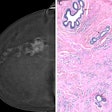Dear AuntMinnie Member,
Should breast cancer screening be extended to women through age 74? Australian researchers addressed this question, and their findings cut to the heart of the debate over the effectiveness of screening.
Most guidelines only support screening through age 69, but the researchers wanted to assess the effect of screening for another five years. They found that while mammography in older women would prevent one additional breast cancer death per 1,000 women, it would also result in "overdiagnosis," the detection of cancers that wouldn't pose a risk to women in their lifetimes. Read more about the study by clicking here.
Their conclusion was that the benefits of screening older women didn't offset the harms. But you might have a different opinion if your death were the one that screening prevented.
The findings raise questions yet again about the value that some public policy experts are placing on harms versus benefits -- an especially pointed question given recent research that women themselves seem to care more about mammography's lifesaving benefit than harms such as overdiagnosis and false positives.
Also in the Women's Imaging Community, a new study has found that many primary care providers aren't really ready to have the shared decision-making discussions with women that are being recommended to determine who should be screened. That story's available by clicking here.
Catch up on the debate in our Women's Imaging Community at women.auntminnie.com.
FMISO-PET for radiation therapy
In other news, French researchers wanted to see how well PET with a novel radiotracer -- F-18 fluoromisonidazole (FMISO) -- performed in guiding the use of a radiotherapy boost in patients with non-small cell lung cancer. The answer? Meh.
They found that while FMISO-PET was feasible and the boost was well-tolerated, patients who received it didn't have better outcomes than those who didn't. Learn more by clicking here.
CT of artery lesions
U.K. researchers are discussing a new technique that could make CT more valuable for predicting which arterial lesions could be at risk of rupture. They call it the fat attenuation index, and we explain how it works in a new story in our CT Community.
Finally, the AuntMinnie family would like to extend its thanks to everyone in the radiology community who has sent condolences on the passing of International Editor Eric Barnes last week. Eric's memorial service is today, and he would be gratified by the tremendous outpouring of support from everyone around the world whose lives he touched.



















